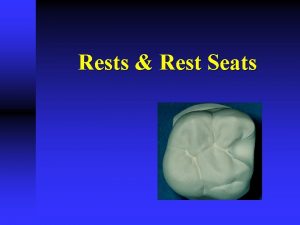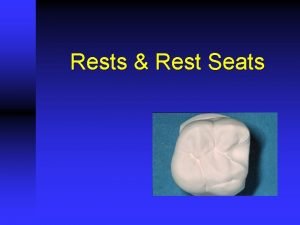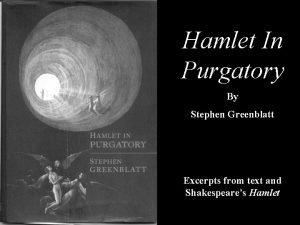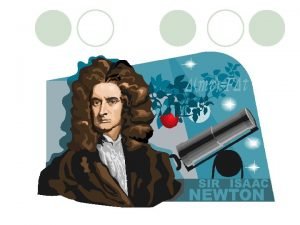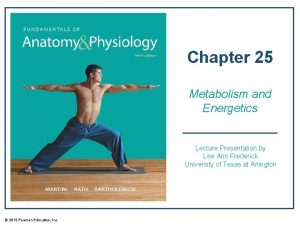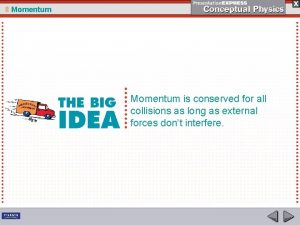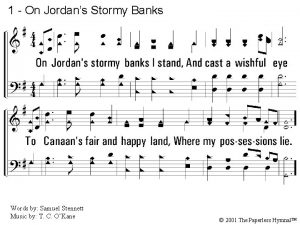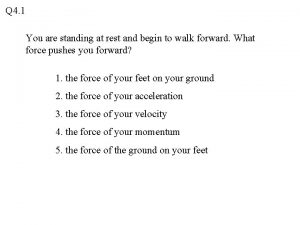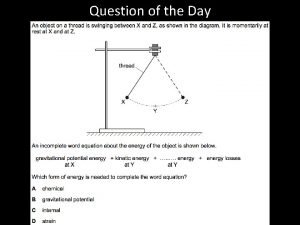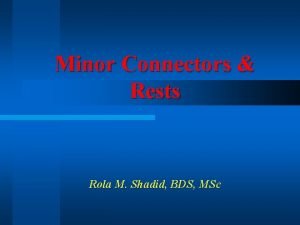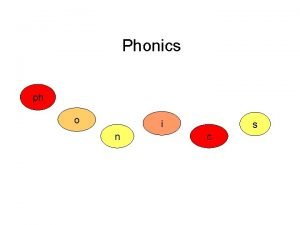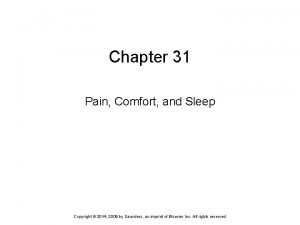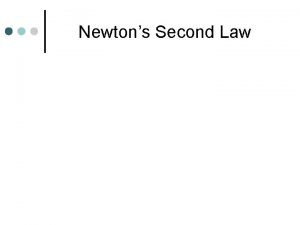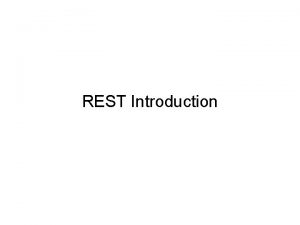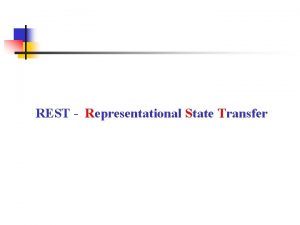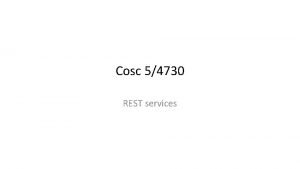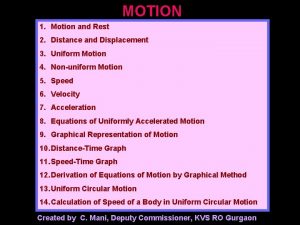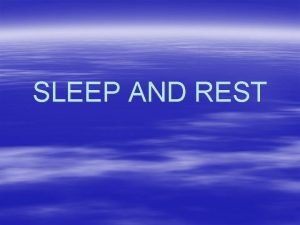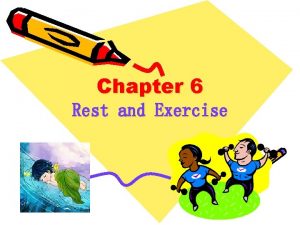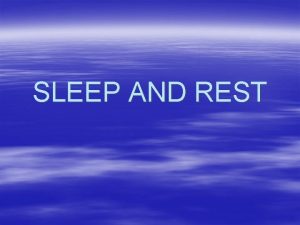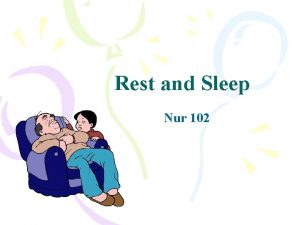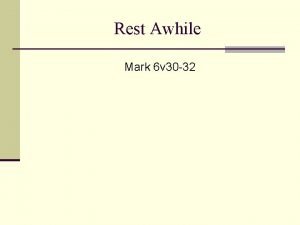MOTION State of Rest and Motion State of
































- Slides: 32

MOTION State of Rest and Motion

State of Rest and Motion : �Rest: In physics the objects which do not change their position are said to be at rest. �Motion : The objects which change their position with respect to their surroundings or with respect to or by both are said to be in motion.

Motion is a relative phenomenon. This means that an object appearing to be in motion to one person can appear to be at rest as viewed by another person. For example , "a person sitting in a moving train is at rest with other passenger but is in motion with respect to the object outside the train. "

TYPES OF MOTION Linear Motion : �Linear motion – where the object moves along a straight line.

Circular Motion �Circular motion – where the object moves along a circular path.

Oscillatory or vibratory motion Oscillatory motion – where an object describes a repetitive to and fro movement retracing its original path.

Random Motion Random motion – where the motion of the object does not fall in any of the above categories.

Uniform and Non Uniform Motion �Uniform motion : An object is said to be in uniform motion if it covers equal distances in equal intervals of time how so ever big or small these time intervals may be. �Non Uniform motion : An object is said to be in non uniform motion if it covers unequal distances in equal intervals of time.

Distance and Displacement �Distance : The actual length of the path travelled by a moving body irrespective of the direction is called the distance travelled by the body. It has only magnitude but no direction. It is a scalar quantity. Unit – metre. �Displacement – It is defined as the change in position of a moving body in a particular direction. It is a vector quantity having both magnitude and direction. It is also measured in metre in SI system.

Difference between distance and displacement: �Observe the motion of a car as shown in figure: D 4 m C 3 m 5 m 3 m A 4 m B

Now answer the following questions : �How much distance covered by the car through the path ABC and AC and compare the values? From this what you observe? �Which path gives the shortest distance to reach A to D? Either the path ABCD or the path AD. Think �What is the total distance covered by the car when it travels the path ABCDA and where it finally reaches? From this what do you understand. How much it covers? What is its displacement?

Speed and velocity �Speed is the rate of change of distance or the distance travelled in unit time. It is a scalar quantity. The SI unit of speed is m/s. �Speed = Distance travelled / Time taken �Velocity is the rate of change of displacement or the displacement in unit time. The SI unit of velocity is m/s. It is a vector quantity. �Velocity = Displacement / Time taken

Acceleration �Acceleration is the rate of change of velocity or it is the change of velocity in unit time. It is a vector quantity. The SI unit of acceleration is m/s 2. �Acceleration = Change in velocity / Time taken �If the velocity decreases with time and the value of acceleration is negative. Negative acceleration is called retardation. �Acceleration = (v - u )/t �Special cases: (i). v<u (ii). v=u (iii) v>u

Graphical representation of Motion along a straight line � The distance – time graph for uniform motion: � The following table shows the distance walked by Surya at different times. � Surya covers equal distances in equal intervals of time. we can therefore conclude that surya walked at a constant speed. Time (minute) Distance (metre) 0 0 5 500 10 1000 15 1500 20 2000 25 2500

Distance-time graph for three different persons: � Let us take a look at the distance-time graphs of three different people -Surya walking, Monica cycling and Hari going in a car , along the same path. We know that cycling can be faster than walking and a car can be go faster than a cycle. The sloe of the line on the distance-time graph becomes steeper and steeper as speed increases.

The distance - time graph for non – uniform motion �Table given below shows the distance travelled by a car in a time of two second. �Note that the graph is not a straight line as we got in the case of uniform motion. Time (second) 0 2 4 6 8 10 12 Distance (metre) 0 1 4 9 16 25 36

Velocity – Time Graph � This graph shows the velocity-time graph for a car moving uniform velocity of 40 km/hr. � The area under the velocity-time graph is equal to the magnitude of the displacement. � The displacement covered by the car in a time interval of t can be expressed as S = AC X CD (area of the rectangle ABCD)

Velocity-time graph for uniformly accelerated motion: � The area under the velocity-time graph gives the distance (magnitude of displacement) moved by the car in a given interval of time. S=area ABCDE =area of the rectangle ABCD + area of the triangle ADE =(AB X BC ) + ½ (AD X DE) Time (Second) 0 5 10 15 20 25 30 Velocity of the Car (m/s) 0 9 18 27 36 45 54

Non- uniformly accelerated motion: � In the case of non uniformly accelerated motion, distance-time graph, velocity-time graphs can have any shape as shown in figure below:

� The whole class can divide themselves into small groups study the graph of the bus travelling from Chennai to Bangalore and discuss the questions given below : � What is the total distance between Chennai and Bangalore? � How long did the bus take for the full journey? � Was the speed of the bus constant? � If the bus halt for sometime during the journey? � If it halted, how long was the halt? � Simply, by looking at the inclination of the graph line, can you tell when the speed was the greatest? � What was the maximum speed that the bus attained during the journey?

� Study the velocity – time graph of the car in the graph and answer the following questions given below: � What was the maximum value of velocity during the journey? � Was the velocity constant during any part of the journey? If so, when was it? � What was the maximum value of acceleration during the journey? When did it occur? � When did the car slow down? � What was the value of acceleration during the final slow down?

Equations of motion � The equations of motion can be written as, v = u + at (this is the relation between velocity and time) s = ut + ½ a t 2 (this is the relation between displacement and time) v 2 = u 2 + 2 as (this is the relation between displacement and velocity) � Equations of motion from velocity – time graph: C B OD = u , OC = v CD = AB = v - u Velocity OE = AD = t D A O E Time

Newton’s first equation of motion � Equation describing relation between velocity and time By definition, acceleration = change in velocity / time = (final velocity – initial velocity)/time = (OC – OD) / OE = DC / OE a = DC / t DC = AB = at v = u + at …………. . (1) From the graph EB = EA + AB This is Newton’s first equation of motion.

Newton’s second equation of motion � Equation describing the relation between displacement and time From the graph the distance covered by the object during time t is given by the area of quadrangle DOEB s = area of the quadrangle DOEB = area of the rectangle DOEA + area of the triangle DAB = (AE X OE) + (1/2 X AB X DA) s = ut + ½ at 2 …………………. . (2) This is Newton’s second equation of motion.

Newton’s third equation of motion � Equation describing the relation between displacement and velocity From the graph the distance covered by the object during time t is given by the area of the quadrangle DOEB. Here DOEB is a trapezium. Then S = area of trapezium DOEB = ½ X sum of length of parallel side X distance between parallel sides = ½ X (OD + BE) X OE s = ½ X (u + v) X t since a = (v-u) / t or t = (v-u) / a Therefore s = ½ X (v + u) X (v – u) / a 2 as = v 2 – u 2 v 2 = u 2 + 2 as (3) ………. . . . . This is Newton’s third equation of motion

Uniform circular motion � Whirl a stone which is tied to the end of a string continuously. Identify its path of motion and observe the nature of force at different positions. Assume that the speed of the stone is constant. (Note: Do it in an open ground when no one is near to you. ) � What is the path of the stone? � It is clear that the path is a circular and the direction of velocity changes at every instant of time but the speed is constant.

Uniform circular motion �When a particle moves on a circular path with a constant speed, then its motion is known as uniform circular motion in a plane. The magnitude of velocity in circular motion remains constant but the direction changes continuously. At all the instances, the particle is moving tangent to the circle.

CENTRIPETAL ACCELERATION AND CENTRIPETAL FORCE: � A body is said to be accelerated, if the velocity of the body changes either in magnitude or direction. Hence the motion of a stone in circular path with constant speed is an accelerated motion. There must be a force acting along the string directed inwards, which makes the stone move in the circular path. � This acceleration is known as centripetal acceleration and the force is known as Centripetal force. Since the centripetal acceleration directed radially towards the centre of the circle, the centripetal force must act on the object radially towards the centre. . . �Any force like gravitational force , frictional force, magnetic force, electro static force , etc… may act as a centripetal force

CENTRIPETAL ACCELERATION AND CENTRIPETAL FORCE:

Centrifugal reaction:

CENTRIFUGAL REACTION: �Centrifugal reaction : �Force acting on a body away from the centre of circular path is called the centrifugal force. �Thus centrifugal force is in a direction opposite to the direction of centripetal force. Its magnitude is same as that of the centripetal force. �But centrifugal force is not the force of reaction of the centripetal force because action and reaction do not act on the same body. It is not the real force, but it is a virtual force by an observer moving in circular path along with the body.

�THANK YOU…. . By, R. Vendhan , M. Sc. , M. Ed. , M. Phil. , PG Teacher , Govt. Boys Hr. Sec. School, Krishnagiri. mbl: 99941 40874 mail id: r. vendhanphysics@gmail. com
 State of rest and motion
State of rest and motion Cingulum rest canine
Cingulum rest canine Intracoronal rest
Intracoronal rest Lingual rest seat
Lingual rest seat Stephen greenblatt hamlet in purgatory
Stephen greenblatt hamlet in purgatory Object at rest stays at rest
Object at rest stays at rest Type of range of motion
Type of range of motion Simple harmonic motion
Simple harmonic motion An object in motion stays in motion
An object in motion stays in motion Chapter 2 motion section 1 describing motion answer key
Chapter 2 motion section 1 describing motion answer key Chapter 2 motion section 1 describing motion answer key
Chapter 2 motion section 1 describing motion answer key Section 1 describing motion
Section 1 describing motion Concept 1 notes describing motion
Concept 1 notes describing motion Motion section 1 describing motion
Motion section 1 describing motion Transition bugs in software testing
Transition bugs in software testing Absorptive state and postabsorptive state
Absorptive state and postabsorptive state Glycogen breakdown
Glycogen breakdown State graph in software testing
State graph in software testing Rest in the lord wait patiently for him
Rest in the lord wait patiently for him Principle of recovery
Principle of recovery A big fish swims up and swallows a small fish at rest
A big fish swims up and swallows a small fish at rest Comfort and rest
Comfort and rest Palm and thumb grasp
Palm and thumb grasp We will rest in the fair and happy land
We will rest in the fair and happy land Hair alternates between periods of growth and rest
Hair alternates between periods of growth and rest A horse is hitched to a wagon. which statement is correct
A horse is hitched to a wagon. which statement is correct Chapter 31 comfort rest and sleep
Chapter 31 comfort rest and sleep Comfort and rest
Comfort and rest A wind up toy is fully wound and at rest
A wind up toy is fully wound and at rest Canine rest seat
Canine rest seat Notes and rests
Notes and rests Chapter 31 pain comfort and sleep
Chapter 31 pain comfort and sleep What is newton's second law
What is newton's second law

